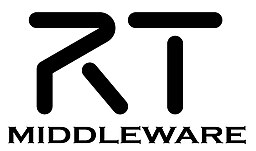RT-middleware (Robotics Technology Middleware) is a common computing platform technical standard for robots based on distributed object technology.[1] RT-middleware supports the construction of various networked robotic systems by integrating various network-enabled robotic elements named RT-Components, which specification standard is discussed and defined by the Object Management Group (OMG).[2]

Properties
editIn the RT-middleware, robotics elements, such as actuators, are regarded as RT-components, and the whole robotic system is constructed by connecting such components. This distributed architecture helps developers reuse the robotic elements and boosts the reliability of a system.
Each RT-component has a port as an endpoint for communicating to other RT-components. Every port has its type and the ports which have the same type can be connected each other.
RT-components also have state, so they behave as finite-state machines. The states they can have are: CREATED, INACTIVE, ACTIVE, and ERROR. States and behaviors are controlled by the execution-context. If component behavior must be changed, the execution-context can be replaced at runtime.
Implementations
editRT-middleware is only a standard of the Robotics platform software. Implementations include:
- OpenRTM-aist is based on the Common Object Request Broker Architecture (CORBA) platform developed by National Institute of Advanced Industrial Science and Technology. Using CORBA properties, OpenRTM-aist is available for environments with multiple platforms and programming languages.[3]
- OpenRTM.NET is for the .NET Framework.[4]
- RTM on Android is being implemented on Android (operating system).[5]
- RTC Lite is a future modified RT-middleware for embedded or small-resource systems.[6]
- RTM Safety to pass the IEC 61508 standard.[7]
Related projects
edit- Robot Operating System (ROS) – C++ software framework developed by Willow Garage.[8][9]
- Open Robot Control Software (Orocos) – C++ software framework for component-based robot control software[10]
- OPRoS[11] developed by Korea Association of Robot Industry (KAR)[12]
See also
editReferences
edit- ^ Ando, Noriaki; Suehiro, Takashi; Kitagaki, Kosei; Kotoku, Tetsuo; Yoon, Woo-Keun (August 2005). RT-Middleware: Distributed Component Middleware for RT (Robot Technology). IEEE/RSJ International Conference on Intelligent Robots and Systems (IROS2005). Edmonton, Canada. pp. 3555–3560.
- ^ "Robotics Technology Component Specification version 1.0". Object Management Group (OMG).
- ^ OpenRTM-aist official website, http://www.openrtm.org/
- ^ SEC. Co., Ltd., [SEC, Robot Site http://www.sec.co.jp/robot/download_rtm.html]
- ^ SEC. Co., Ltd., [RTM Safety http://www.sec.co.jp/english/business/rtmsafety/]
- ^ SEC. Co., Ltd., [RTM Safety http://www.sec.co.jp/english/business/rtmsafety/]
- ^ SEC. Co., Ltd., [RTM Safety http://www.sec.co.jp/english/business/rtmsafety/]
- ^ "ROS – Robot Operating System". ROS.org.
- ^ "willowgarage.com". Willow Garage.
- ^ Orocos.org
- ^ "OPRoS". 3 January 2011. Archived from the original on 2011-07-04.
- ^ "KAR". Korea Association of Robot Industry.